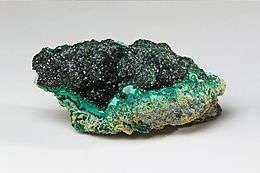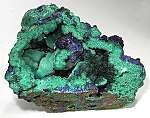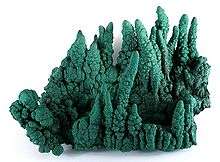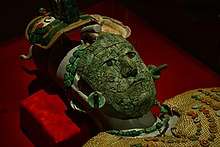Malachite
Malachite is a copper carbonate hydroxide mineral, with the formula Cu2CO3 (OH)2. This opaque, green-banded mineral crystallizes in the monoclinic crystal system, and most often forms botryoidal, fibrous, or stalagmitic masses, in fractures and deep, underground spaces, where the water table and hydrothermal fluids provide the means for chemical precipitation. Individual crystals are rare, but occur as slender to acicular prisms. Pseudomorphs after more tabular or blocky azurite crystals also occur.[4]
| Malachite | |
|---|---|
 Malachite from the Democratic Republic of the Congo | |
| General | |
| Category | Carbonate mineral |
| Formula (repeating unit) | Cu2CO3(OH)2 |
| Strunz classification | 5.BA.10 |
| Crystal system | Monoclinic |
| Crystal class | Prismatic (2/m) (same H-M symbol) |
| Space group | P21/a |
| Identification | |
| Formula mass | 221.1 g/mol |
| Color | Bright green, dark green, blackish green, with crystals deeper shades of green, even very dark to nearly black commonly banded in masses; green to yellowish green in transmitted light |
| Crystal habit | Massive, botryoidal, stalactitic, crystals are acicular to tabular prismatic |
| Twinning | Common as contact or penetration twins on {100} and {201}. Polysynthetic twinning also present. |
| Cleavage | Perfect on {201} fair on {010} |
| Fracture | Subconchoidal to uneven |
| Mohs scale hardness | 3.5–4 |
| Luster | Adamantine to vitreous; silky if fibrous; dull to earthy if massive |
| Streak | light green |
| Diaphaneity | Translucent to opaque |
| Specific gravity | 3.6–4 |
| Optical properties | Biaxial (–) |
| Refractive index | nα = 1.655 nβ = 1.875 nγ = 1.909 |
| Birefringence | δ = 0.254 |
| References | [1][2][3][4] |
Etymology and history

The stone's name derives (via Latin: molochītis, Middle French: melochite, and Middle English melochites) from Greek Μολοχίτης λίθος molochites lithos, "mallow-green stone", from μολόχη molochē, variant of μαλάχη malāchē, "mallow".[5] The mineral was given this name due to its resemblance to the leaves of the mallow plant.[6]
Malachite was extensively mined at the Great Orme Mines in Britain 3,800 years ago, using stone and bone tools. Archaeological evidence indicates that mining activity ended c. 600 BCE, with up to 1,760 tonnes of copper being produced from the mined Malachite.[7][8]
Archaeological evidence indicates that the mineral has been mined and smelted to obtain copper at Timna Valley in Israel for more than 3,000 years.[9] Since then, malachite has been used as both an ornamental stone and as a gemstone.
Occurrence
Malachite often results from the weathering of copper ores, and is often found with azurite (Cu3(CO3)2(OH)2), goethite, and calcite. Except for its vibrant green color, the properties of malachite are similar to those of azurite and aggregates of the two minerals occur frequently. Malachite is more common than azurite and is typically associated with copper deposits around limestones, the source of the carbonate.
Large quantities of malachite have been mined in the Urals, Russia. Ural malachite is not being mined at present,[10] but G.N Vertushkova reports the possible discovery of new deposits of malachite in the Urals.[11] It is found worldwide including in the Democratic Republic of the Congo; Gabon; Zambia; Tsumeb, Namibia; Mexico; Broken Hill, New South Wales; Lyon, France; Timna Valley, Israel; and the Southwestern United States, most notably in Arizona.[12]
Use
Malachite was used as a mineral pigment in green paints from antiquity until c. 1800.[14] The pigment is moderately lightfast, sensitive to acids, and varying in color. This natural form of green pigment has been replaced by its synthetic form, verditer, among other synthetic greens.
Malachite is also used for decorative purposes, such as in the Malachite Room in the Hermitage Museum, which features a huge malachite vase, and the Malachite Room in Castillo de Chapultepec in Mexico City. "The Tazza", a large malachite vase, one of the largest pieces of malachite in North America and a gift from Tsar Nicholas II, stands as the focal point in the centre of the room of Linda Hall Library.
Symbolism and superstitions
A 17th-century Spanish superstition held that having a child wear a lozenge of malachite would help them sleep, and keep evil spirits at bay.[15] Marbodus recommended malachite as a talisman for young people because of its protective qualities and its ability to help with sleep.[16] It has also historically been worn for protection from lightning and contagious diseases and for health, success, and constancy in the affections.[17] During the Middle Ages it was customary to wear it engraved with a figure or symbol of the Sun to maintain health and to avert depression to which Capricorns were considered vulnerable.[18]
In ancient Egypt the colour green (wadj) was associated with death and the power of resurrection as well as new life and fertility. Ancient Egyptians believed that the afterlife contained an eternal paradise, referred to as the "Field of Malachite", which resembled their lives but with no pain or suffering.[19]
Gallery
 Slice through a double stalactite, from Kolwezi, Democratic Republic of the Congo. Size 5.9 × 3.9 × 0.7 cm.
Slice through a double stalactite, from Kolwezi, Democratic Republic of the Congo. Size 5.9 × 3.9 × 0.7 cm.
 Malachite stalactites (to 9 cm height), from Kasompi Mine, Katanga Province, Democratic Republic of the Congo. Size: 21.6×16.0×11.9 cm.
Malachite stalactites (to 9 cm height), from Kasompi Mine, Katanga Province, Democratic Republic of the Congo. Size: 21.6×16.0×11.9 cm.- Sample of malachite found at Kaluku Luku Mine, Lubumbashi, Shaba, Congo
.jpg) Vase in malachite in the Hermitage Museum, St Petersburg
Vase in malachite in the Hermitage Museum, St Petersburg
See also
References
- Mineralienatlas
- Anthony, John W.; Bideaux, Richard A.; Bladh, Kenneth W.; Nichols, Monte C., eds. (2003). "Malachite" (PDF). Handbook of Mineralogy. V (Borates, Carbonates, Sulfates). Chantilly, Virginia: Mineralogical Society of America. ISBN 0962209740.
- Malachite. Webmineral
- Malachite. Mindat
- Malachite, Dictionary.com
- Harper, Douglas. "malachite". Online Etymology Dictionary.
- Johnson, Ben, ed. (2014). "The Great Orme Mines". Retrieved 2017-06-06.
- Ruggeri, Amanda (21 April 2016). "The Ancient Copper Mines Dug By Bronze Age Children". BBC. Retrieved 2017-06-06.
- Parr, Peter J. (1974). "Review of 'Timma: Valley of the Biblical Copper Mines' by Beno Rothenberg Bulletin of the School of Oriental and African Studies, University of London, Vol. 37, No. 1, pp. 223–224
- Куда делись символы России? Argumenty i Fakty (24 May 2006)
- Somin, L. M. Тайны седого Урала. Малахит. oldrushistory.ru
- Mindat map with over 8500 locations. mindat.org
- "The Red Queen and Her Sisters: Women of Power in Golden Kingdoms". www.metmuseum.org. Retrieved 13 October 2018.
- Gettens, R.J. and Fitzhugh, E. W. (1993) "Malachite and Green Verditer", pp. 183–202 in Artists’ Pigments. A Handbook of Their History and Characteristics, Vol. 2: A. Roy (Ed.) Oxford University Press. ISBN 0894682601
- The Illustrated Book of Signs and Symbols by Miranda Bruce-Mitford, Dorling Kindersley Limited, London, 1996, p. 41
- The Book of Talismans, Amulets and Zodiacal Gems, by William Thomas and Kate Pavitt, [1922], p. 254
- The Book of Talismans, Amulets and Zodiacal Gems, by William Thomas and Kate Pavitt, [1922], p. 254
- The Book of Talismans, Amulets and Zodiacal Gems, by William Thomas and Kate Pavitt, [1922], p. 254
- Hill, J (2010). "Meaning of green in ancient Egypt". Ancient Egypt Online. Retrieved 2016-11-28.
Further reading
- Hurlbut, Cornelius S.; Klein, Cornelis, 1985, Manual of Mineralogy, 20th ed., John Wiley and Sons, New York ISBN 0-471-80580-7.
- Virtual tour of the Malachite Room
- Malachite, Colourlex
